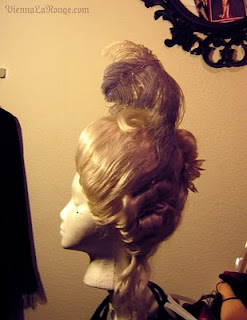The hair.
In some cases, it's all about the hair.
And it has to be right, otherwise you run the risk of looking "costumey".
We've all seen it, or had to deal with it ourselves; that Halloween costume wig at an historical event, its synthetic fibers gleaming with a blinding sheen from any light source that hits it. Worst of all, from the camera flash.
Synthetic hair shine can be tamed down, and a little shine is ok. It's when the hair *looks* plastic, and that's a common problem.
Victorian style hair falls, braids and pieces are one thing, but the 18th century dos from the last third of the century are particularly difficult.
All the piling, winding, smoothing, bouffanting(is that even a word?), bunting, pomading, gluing, curling and balancing.
In some cases, such as wig and hair styles of the 1770s, the less 'natural' the better. Again, just don't let it look too shiny, gods forbid.
Here is an early experiment of mine, using a
costume wig and stuffing from an old pillow (Obviously shiny, before I applied powder).

Then in the 1780s and 90s, hair became this kind of large, free flowing teased halo of waves, curls or frizz, often with tendrils of long ringlets cascading from the neck down the back, or caressing a shoulder.
I did this style once with a costume wig called the
Alonge, made by a wig co. called Lacey.
I wish I had photos of this wig after my alterations to it. My only problem was that the wig I had was black, and I wanted blonde.
I just bought a blonde one via Ebay, and it's on the way to me now.
Many people think that everyone had white wigs during the 18th c., but most of those were actually a medium to light blonde, then powdered. Red and deep auburn/brown was also popular, powdered or not.
This is the Alonge wig in blonde, un-brushed:

But with the previous one I had in black; by brushing out the curls on top and trimming/teasing as needed, it created the perfect Georgian era hairstyle. I ended up trimming away some of the long ringlets that hung down from the lower back of the wig, only keeping about 4 or 5 at the center back. I brushed up and styled the trimmed ringlets into the rest of the wig.
It looked amazing, but again, it was a random experiment I did while bored. I thought about powdering it, but didn't really want a black wig powdered. It just made me think I would end up with an 'old lady with grey hair' look.
When I get the blonde wig, I will post my progress with tips and photos, so you can see how I do it. I'm going for a look similar to the styles in these portraits:


Oh! Tip of the day in regard to making powdered wigs; Instead of using powder then hairspray, or vice-versa; Use hairspray to do most of your setting, then spray lightly with that temporary hair color spray in white. Or even pink or blue, popular 18th c. "costumey" colors for wigs ;-)
Start light for lightly powdered look, then add more coats for a more heavily powdered look.
Kryolan is the best, and used by theater and film professionals:
http://www.alconeco.com/products/character/temporary_hair_color/kryolan_color_spray
If you don't want a powdered look, but want to cut the shine of a synthetic wig, use a spray color that matches your wig color.
xoxox,
~Vienna









